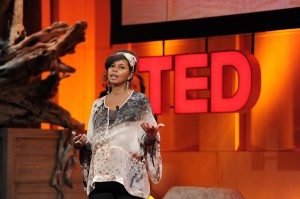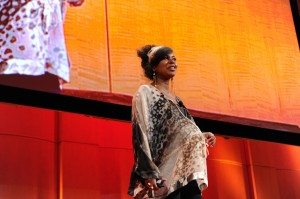
Chaffer’s flick makes a stand for babies with a contempt for all things befouled with toxicity.
By Penelope Jagessar Chaffer, LuxEco Advocate and producer of Toxic Baby, with an intro by Alanna Brown, LuxEco Editorial Assistant
It was tremendous to be among the first general audience that would view Penelope Jagessar Chaffer’s Toxic Baby. As a LuxEco editorial assistant, I was already privy to the toxicity of many personal care products and cosmetics. But changing my ways was a different story. There comes a fork in the road when your mind is opened to awareness…you can do something about this new knowledge or go on pretending it’s not real, or important, or it’s too inconvenient. I was still standing at that fork in the road, looking down each path, trying to decide if I should stop just preaching green and start really living it; possessing a mindful cognizance, but lacking a visceral one. After the Toxic Baby screening, my choice was made before the lights came back on. I now buy things that are made from 100% natural materials, or at least close. I purchase products that are paraben-free, phthalate-free, and sulfate-free. I steer clear of products containing synthetic fragrance. And I know this is just the start; this knowledge will continue to bleed into all areas of my life. Toxic Baby blasted my eyes open and placed a visceral urgency within me. I have no doubt that this documentary will do the same for audiences around the world. Watch the film and get ready to change your life—and the lives of generations to come.
When Nancy and Jim Chuda founders of LuxEco Living and Healthy Child Healthy World graciously suggested hosting a screening for Toxic Baby, I was thrilled, yet curious. The select audience would be comprised of a group of young people, the demographic mostly female and only one who was a mom. It was the first viewing to a group of people who were not scientists, environmental advocates, or those involved in film and television. How would it play out?
Regarding the issue of toxicity, Iʼve always felt that our society stares, divided, at the edge of a precipice. Some of us advocate immediate action to regulate the tens of thousands of chemicals in existence, others advocate the status quo. Most of us are unaware, obliviously moving with the herd ever closer to the big tumble. The issue is one of the biggest environmental concerns that the planet faces, yet sits obscured behind our frantic, complicated, draining modern day lives − our twenty-first century toxic lives.
So, with bated breath, in a darkened room, I surreptitiously scanned the watching faces. Now, bated breath when you are eight months pregnant is clearly not a good idea, but I could not help myself. I watched the audience’s hearts sink when the statistics of childhood disease rolled across the screen, and I finally breathed when their laughter fanned out after viewing the humorous animations that revealed bodily processes in a way never seen before. I felt their mounting despair and their sense of acute incredulity when scientist after scientist outlined the research that dramatically demonstrated the repercussions of environmental chemical exposure on our children. They all seemed to think, “How could this be true?” And at the end, I watched them stagger out into the light of awareness.
Watching all those faces take on the enormity of the issue was challenging, but by arming them with a fistful of facts, suggestions, and practical advice, I saw how people could be informed and empowered. I watched the dawning realization on the face of the lone mother of the group, Lisa Adams a chemist and interior closet designer, who explained incredulously that she wondered why her child was constantly unwell, and that her mother had pinned it on exposure to “all this stuff that we have now.” I watched the teacher realize the importance of monitoring the products used in schools where our babies will spend most of their waking day. And finally, watching the hip young things realize that they could reduce the toxicity in their lives now to improve the health of their children to come, I felt rewarded for all the years of making a film of this scale and size.
This scene played out again, on stage at the TEDWomen conference in Washington, D.C. less than two months later. I had been invited to speak with renowned frog specialist Professor Tyrone Hayes, who appears in Toxic Baby. We were greeted with the same gasps of incredulity and shock, laughter and dismay. This time, however, I could clearly see the rows of faces numbly taking it all in, and when I pointed out that we know so much about global warming and climate change, yet still do not know about the importance of our bodies’ internal environments, I saw a thousand (LED) light bulbs go off all at once. The journalist Marcia G. Yerman listed our talk among the highlights of the TED conference in the Huffington Post. Christy Turlington, in her blog, called it “One of the more thought provoking talks…”
Standing on the same stage as Hilary Clinton, Donna Karan, Madeline Albright, Naomi Klein, Ted Turner and a star turn of over fifty inspiring men and women, underscored the importance of the work of thousands of scientists around the world and why we need to hear what they have to say.
Iʼm often asked if this is a hopeless time, and I can sense the overwhelming despair that swirls around us all when we contemplate the enormity of this complex issue. I always try to remind people that while it might seem a terrifying time, it is also the best of times. Yes, it would be better if we didnʼt have to deal with this at all, but we have to, and we have real opportunities for change. There are landmark pieces of legislation sitting in the House and Senate, which, if passed, will drastically reduce the toxicity of millions of Americans. International awareness and emerging legislation across the developed world seeks to make this one of the most globally united environmental issues.
We now have more alternatives to harmful products and more options than at any other time in history. Most importantly, with one click of a mouse, we have the Internet , which provides awareness and access to information, support, resources and organizations such as Healthy Child Healthy World, which do so much to help us all navigate this shifting landscape.
All we have to do is act. We stand at the cusp of momentous times−at the shifting transformation from ignorance to awareness to action. Action not only for us and our children, but for our children’s children and generations to come. Research shows that grandchildren have more chemicals in their bodies than their grandparents. Adults have over 30,000 different chemicals in their bodies than their grandparents, simply because these chemicals weren’t yet invented.
This is the time to act. It is a time when we can change the trajectory of this story. And when I think of my child as an adult having his children, and I can see the importance of this time now, I am reminded of Dickens’ words: “It was the best of times, it was the worst of times, it was the age of wisdom, it was the age of foolishness, it was the epoch of belief, it was the epoch of incredulity, it was the season of Light, it was the season of Darkness, it was the spring of hope, it was the winter of despair. We had everything before us…”













